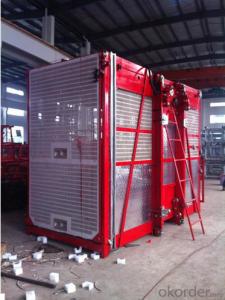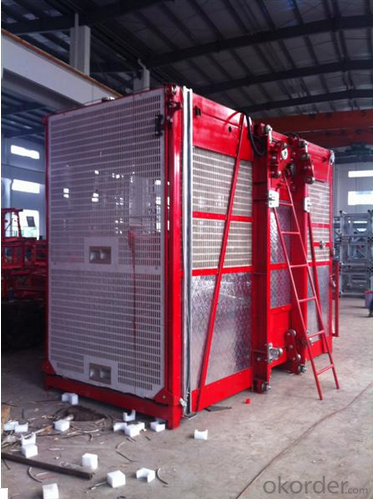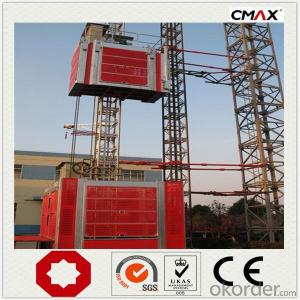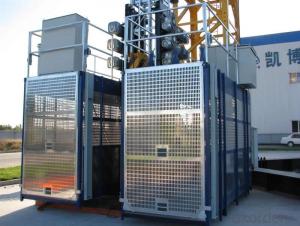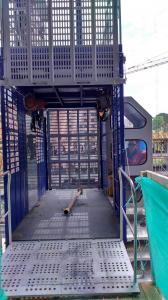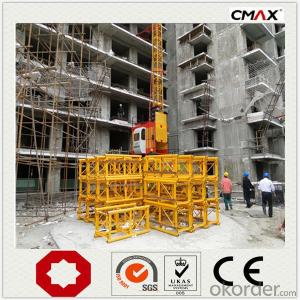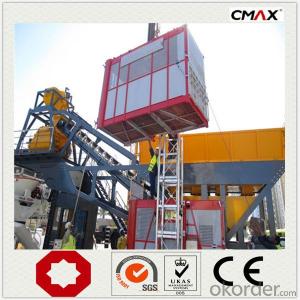33m/min Rack and Pinion New Building Material Hoist
- Loading Port:
- China main port
- Payment Terms:
- TT OR LC
- Min Order Qty:
- 1 pc
- Supply Capability:
- 1000 pc/month
OKorder Service Pledge
OKorder Financial Service
You Might Also Like
Structure of Building Hoist:
1.Reliable quality, long life span, wide application range and convenient maintenance.
2.Key parts of driving system are imported and customized with reliable quality.
3.The electrical parts are from world-famous manufactures, such as Schneider, Siemens and Toshiba.
4.The racks and gears adopt special material and heat-treatment technique.
5.The steel structure is from famous domestic manufactures with high quality. The surface of the structure can adopt paint-spray or hot galvanized according to your requirements
6.The soft starting and braking makes no impact and the machine can be operated easily and smoothly.
7. The system has over-voltage protection, low-voltage protection, over-current, over-load and over speed protection functions.
Advantages of Building hoist
Our advantage:
1- More than 130,000 employee.
2- state-owned company and Fortune 500 enterprises.
3- own systems of production engineering.
4- 10 service branch in the work, such as UAE. KSA. IRAN, USA. INDIA, RUSSIA...
5- Professional construction equipment supplier.
6- technical experts with great experience in the sector.
7- More pls visit our factory, you will find we are your best choice.
Hoist Advantages:
1. Quality raw material, strict production management and career responsibility to make the hoist with the highest safety control, and the advanced design make it with good vision to enhance the safety.
2. Simple structure and low cost
3. Convenient in installation, disassembly and maintenance.
4. Energy-saving, starting current is lower than the rated current.
5. Adjustable speed, the maximum speed could reach 96m/min.
6. Frequency conversion control system, stable starting and breaking and low mechanical wear .
Building Hoist Images:
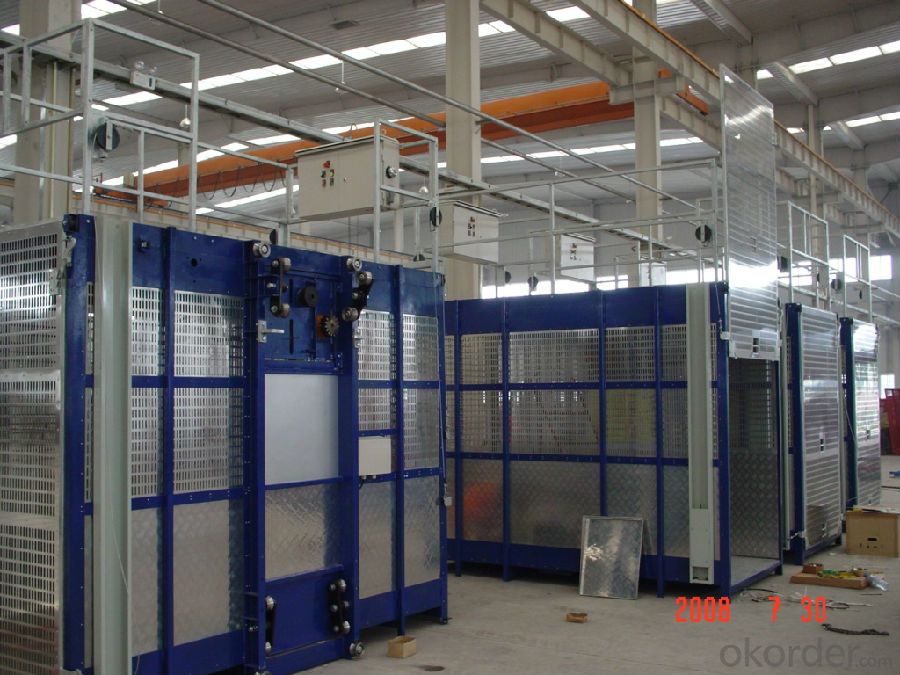
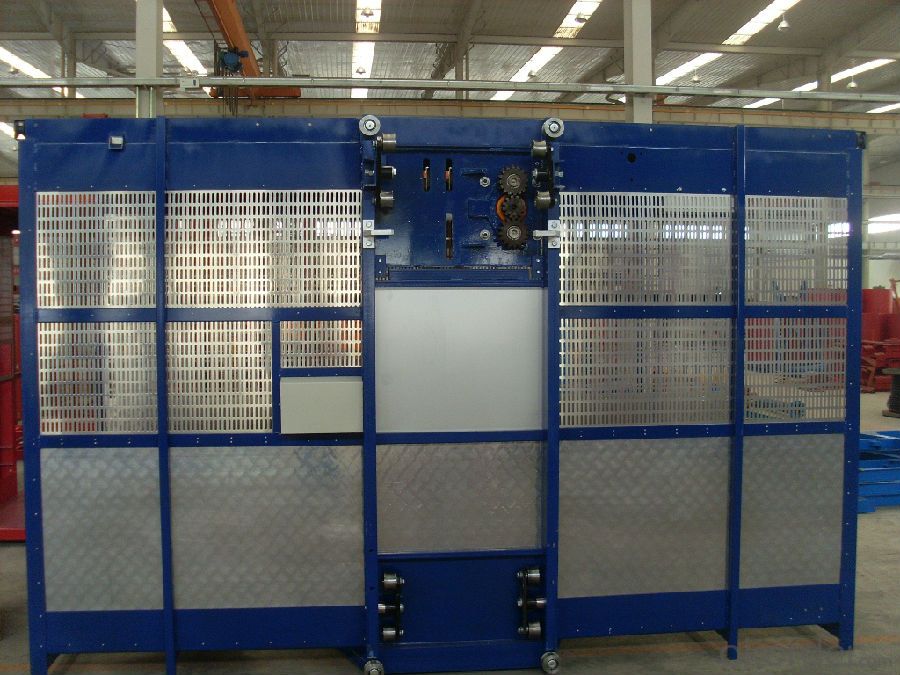
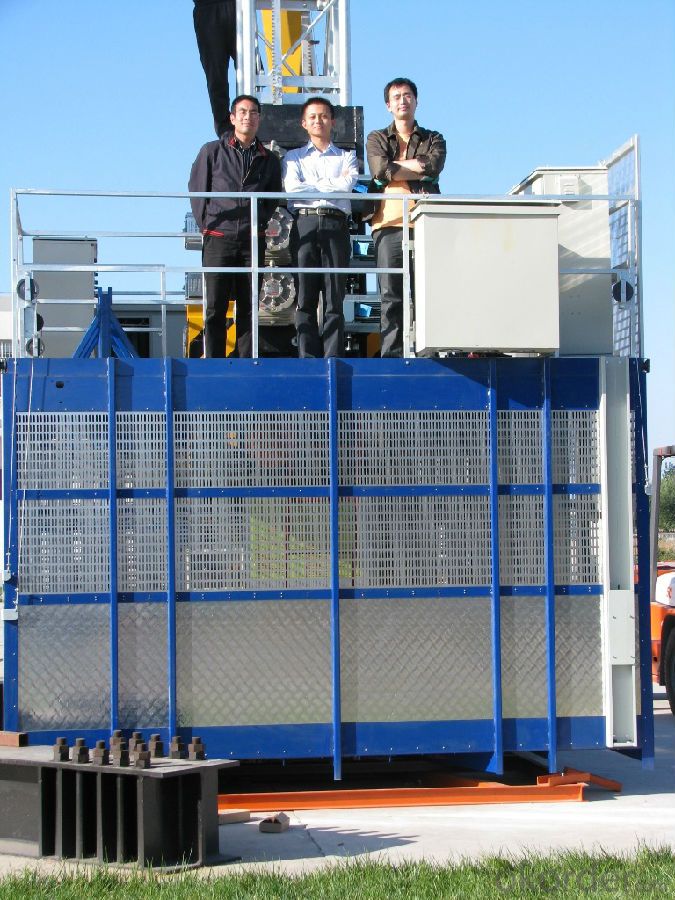
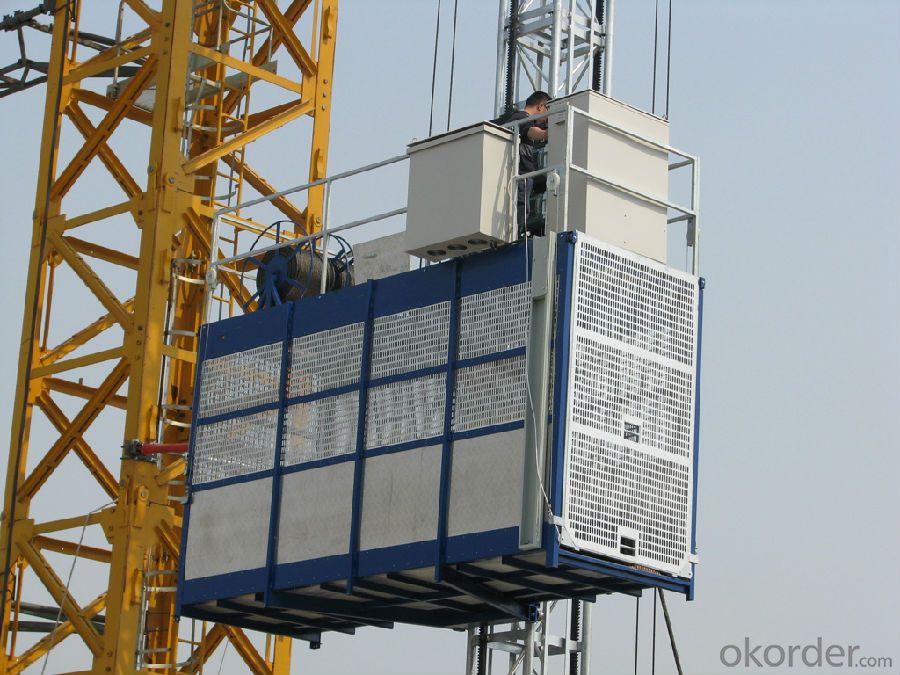
Building hoist Specifiction:
| Model(single and double cage) | Capacity(kgs) | Lifting speed(m/min) | Motor power(kw) |
| SC100TD | 1000 | 36 | 2x11 |
| SC200TD | 2000 | 36 | 3x11 |
| SC270TD | 2700 | 36 | 3x15 |
| SC320TD | 3200 | 36 | 3x18.5 |
| SC100/100TD | 2x1000 | 36 | 2x2x11 |
| SC200/200TD | 2x2000 | 36 | 2x3x11 |
| SC270/270TD | 2x2700 | 36 | 2x3x15 |
| SC320/320TD | 2x3200 | 36 | 2x3x18.5 |
| SC100GZ | 1000 | 0-63 | 2x15 |
| SC200GZ | 2000 | 0-63 | 3x18.5 |
| SC270GZ | 2700 | 0-63 | 3x22 |
| SC200/200GZ | 2x2000 | 0-63 | 2x3x15 |
| SC270/270GZ | 2x2700 | 0-63 | 2x3x18.5 |
| SC320/320GZ | 2x3200 | 0-63 | 2x3x22 |
| SC100/100G | 2x1000 | 0-96 | 2x2x22 |
| SC200/200G | 2x2000 | 0-96 | 2x2x22 |
| SC270/270G | 2x2700 | 0-96 | 2x2x22 |
FAQ of Building Hoist:
Q: What is the building hoist main purpose?
A: Building hoist equipped with double or single cabin to transport the materials and labors up and down. It's the ideal
construction equipment for vertical transportation in the field of construction.
Q: What is the main structure of building hoist?
A: The P/M construction hoist mainly contains metal structure, driving system, electrical control system, cable guide &
protection system, electrical top crane and safety device.
Q: What is the meaning of the building hoist’s code?
A: Take SC200/200 for example: “SC” stands for rack and pinion hoist, “200/200” stands for double cage and capacity
is 2 tons per cage. “SC200” stands for single cage and capacity is 2 tons.
Q: What is the dimension of the cage?
A: Normally the cage dimension is 3X1.5X2.5M (L/W/H) for 2t type hoist. Details should be checked according to our
quotation sheet. Also, the size can be customized according to the factual site condition. There are two doors (entrance
& exit doors) for each cage, It can be produced as up & down sliding or ramping model for safety and convenience
- Q: This question asks for a list of various types of lifting equipment commonly used in the construction industry.
- <p>In construction, various types of lifting equipment are utilized to move heavy materials and structures. These include cranes such as tower cranes, mobile cranes, and crawler cranes, which are versatile and can lift heavy loads to significant heights. Forklifts are used for lifting and moving materials over short distances. Telescopic handlers, also known as cherry pickers, provide both lifting and access capabilities. Hoists are used for lifting smaller loads and are often found in workshops or on construction sites. Derricks are fixed structures used for lifting heavy loads in a specific area. Lifting slings and shackles are used in conjunction with cranes and hoists to secure loads. Finally, aerial work platforms, like scissor lifts and boom lifts, provide elevated access for workers and materials. Each type of lifting equipment serves a specific purpose and is chosen based on the nature of the construction project and the weight and size of the loads to be moved.</p>
- Q: Is it possible to utilize a building hoist for the purpose of lifting heavy equipment or machinery?
- <p>Yes, a building hoist can be used for lifting heavy equipment or machinery, provided it has the necessary capacity and safety features. These hoists are designed to handle substantial loads and are commonly used in construction for moving materials and equipment. However, it's crucial to ensure that the hoist is rated for the weight of the equipment, and all safety protocols are followed to prevent accidents. Regular maintenance and inspection are also essential to ensure the hoist's reliability and safety during heavy lifting operations.</p>
- Q: This question asks if single-rope lifts can experience malfunctions or create safety risks.
- <p>Yes, single-rope lifts can malfunction and pose safety hazards. Like any mechanical system, they are subject to wear and tear, component failure, and human error. Factors such as inadequate maintenance, poor weather conditions, and operator negligence can lead to malfunctions. Safety hazards may include rope breakage, sudden stops, or even derailment. However, modern lifts are equipped with multiple safety features such as emergency brakes and redundant systems to minimize these risks and ensure passenger safety. Regular inspections and adherence to safety protocols are crucial to prevent malfunctions and maintain the safety of single-rope lifts.</p>
- Q: The construction elevator can only go up can't come down what happened
- It hasn't risen yet, how it has fallen! Is it a brain teaser?
- Q: This question asks whether a double-rope lifting system can be safely and effectively used in both indoor and outdoor environments, specifically during windy conditions.
- <p>A double-rope lifting system can be used both indoors and outdoors, but its use in windy conditions requires careful consideration. Indoors, it is generally safe and effective. Outdoors, windy conditions can pose challenges. High winds may cause the load to sway, potentially leading to accidents. Therefore, it's crucial to adhere to safety guidelines, which often recommend not using such systems in winds exceeding certain speeds, typically around 20-30 mph. Always check the manufacturer's specifications and local regulations for safe operating conditions.</p>
- Q: This question asks for an explanation of the functioning of hydraulic cylinders in lifting equipment.
- <p>Hydraulic cylinders in lifting equipment operate by converting hydraulic pressure into linear mechanical motion. They consist of a cylinder barrel, a piston, and a piston rod. When pressurized fluid is introduced into the cylinder, it pushes the piston, which in turn moves the piston rod. This movement is what lifts or moves the load. The force exerted by the piston is proportional to the pressure of the fluid and the area of the piston. The cylinder's design allows for controlled and precise lifting, making it ideal for heavy-duty applications where power and control are required.</p>
- Q: What are the necessary maintenance and inspection procedures for hydraulic building hoists to ensure their safe and efficient operation?
- <p>Hydraulic building hoists require regular maintenance and inspection to ensure safety and efficiency. Daily checks should include visual inspections for leaks, proper functioning of controls, and safe operation of the hoist. Monthly inspections should cover the condition of hydraulic hoses, cylinders, and seals. Annual inspections should be conducted by a qualified professional to check the structural integrity, load-bearing components, and overall mechanical condition of the hoist. Regular lubrication of moving parts and replacement of worn components are also crucial. Always adhere to the manufacturer's guidelines and local regulations for maintenance and inspection intervals.</p>
- Q: This question asks whether a building hoist can be utilized both indoors and outdoors and seeks an explanation for its suitability in both environments.
- <p>A building hoist can be used both indoors and outdoors, depending on the specific design and construction. Outdoor hoists are typically built to withstand weather conditions and are more robust, while indoor hoists are designed for controlled environments. The choice between indoor and outdoor use is determined by factors such as the building's structure, the materials being lifted, and the environmental conditions. Outdoor hoists may require additional features like weatherproofing and corrosion resistance, whereas indoor hoists focus on efficiency and ease of use within a protected setting.</p>
- Q: This question asks about the safety measures that should be taken to ensure the safe operation of a building hoist during lifting.
- <p>To ensure the safety of the lifting operation of a building hoist, several key measures should be taken: Regular inspection and maintenance of the hoist equipment to ensure all components are in good working order. Adherence to the manufacturer's guidelines and safety standards for operation. Proper training for operators to ensure they understand how to use the hoist safely. Implementing a safety checklist before each use. Ensuring the load is secured properly and does not exceed the hoist's weight capacity. Using appropriate safety gear such as safety harnesses and helmets. Having a spotter or signal person to assist the operator and watch for potential hazards. Regularly checking the weather conditions to avoid operating in high winds or other adverse weather that could compromise safety.</p>
- Q: Is it possible to use a building hoist to lift multiple objects simultaneously?
- <p>Yes, it is possible to use a building hoist to lift multiple objects at once, provided the total weight of the objects does not exceed the hoist's load capacity. It's important to ensure that the objects are securely fastened to prevent any from falling. Additionally, safety protocols should be followed to avoid overloading the hoist, which can lead to mechanical failure or accidents. Always consult the hoist's specifications and safety guidelines before lifting multiple objects.</p>
Send your message to us
33m/min Rack and Pinion New Building Material Hoist
- Loading Port:
- China main port
- Payment Terms:
- TT OR LC
- Min Order Qty:
- 1 pc
- Supply Capability:
- 1000 pc/month
OKorder Service Pledge
OKorder Financial Service
Similar products
Hot products
Hot Searches
Related keywords
